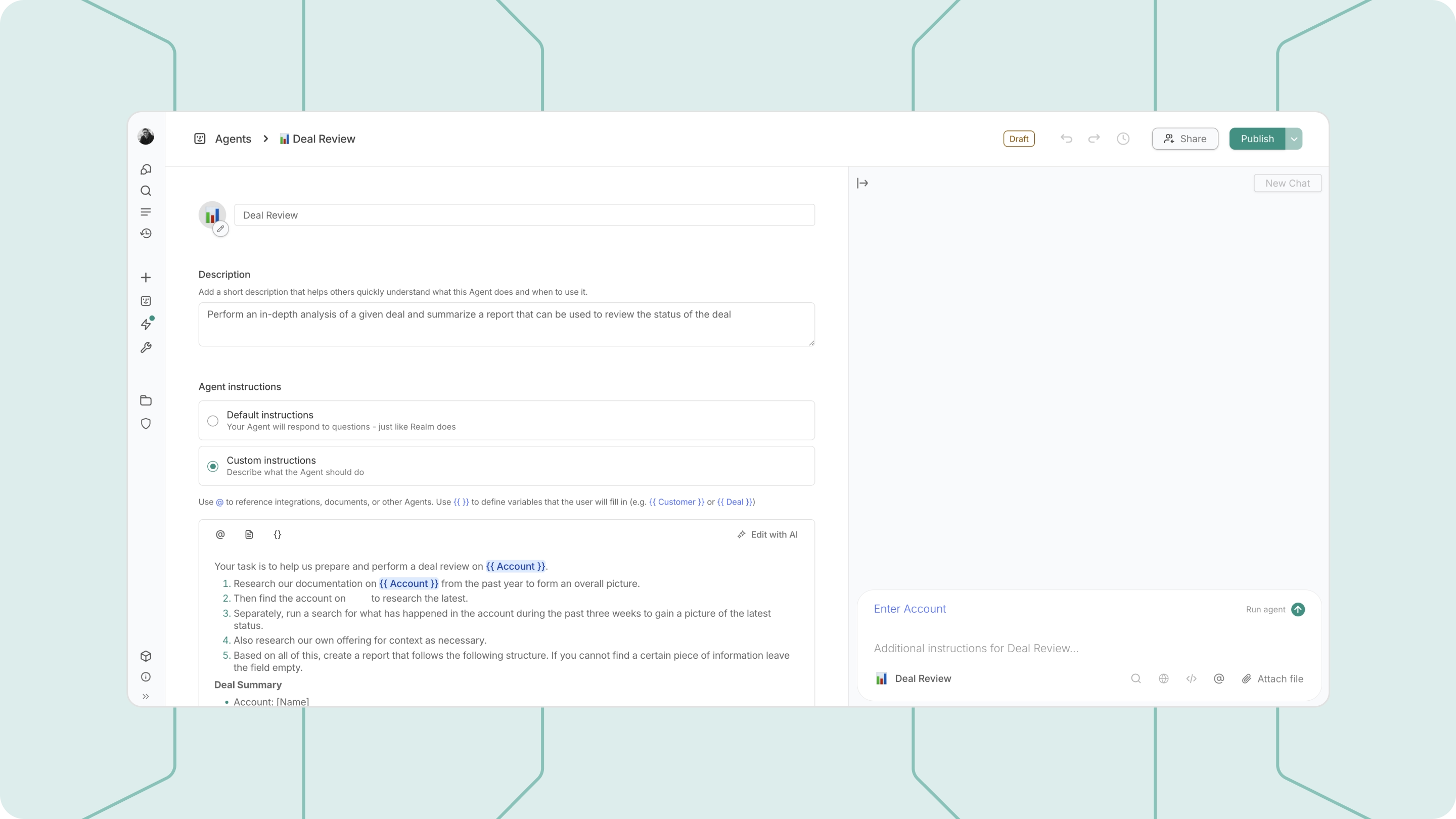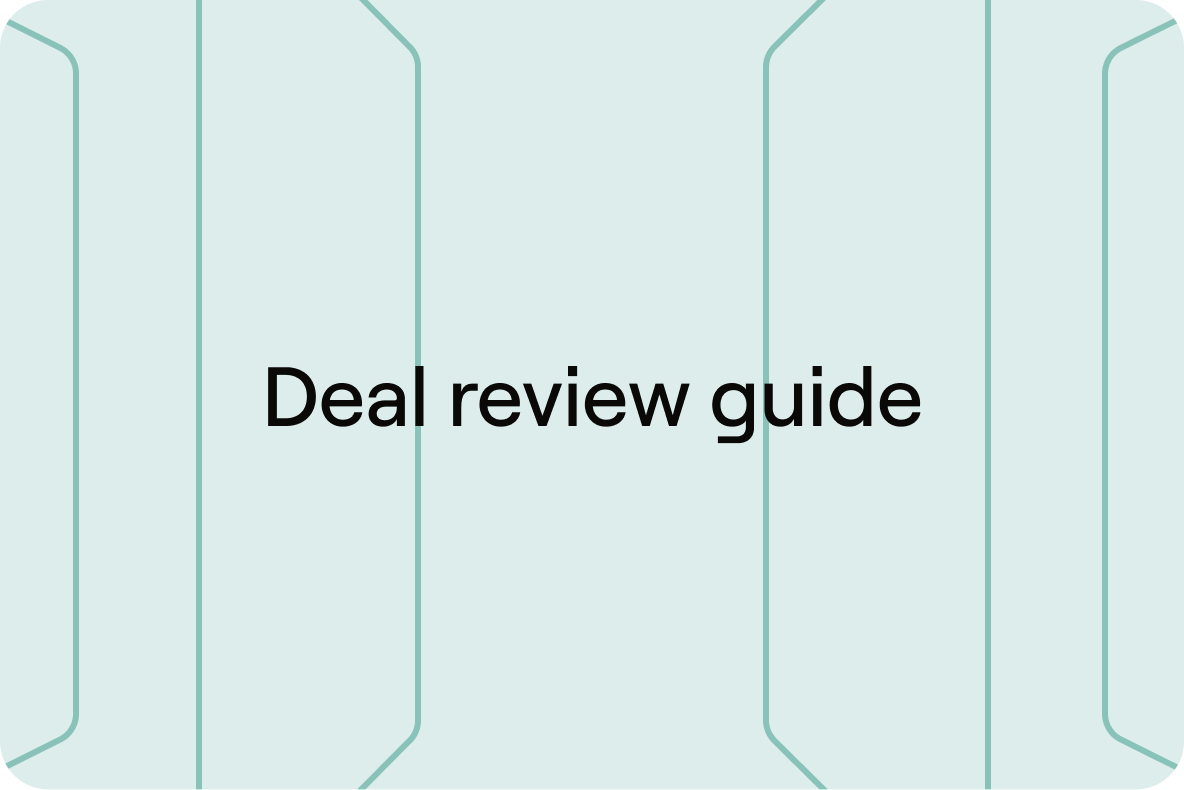Your AE is six weeks into a $300K deal. Discovery went well, the VP loves your product, and the forecast says "commit." Then in week seven, you learn there's a procurement process nobody mentioned, a CFO who hasn't heard your name, and a competitor who's been working the account for three months.
Deal reviews exist to prevent this. They're structured meetings where sales reps and managers dissect individual opportunities, examining stakeholders, decision processes, competitive threats, and risks, before those issues kill the deal.
This guide explains what deal reviews are, why they matter, how to run them effectively, and how to automate the process with AI so your team spends less time preparing and more time selling.
What is a deal review?
A deal review is a structured meeting where sales reps and managers examine specific opportunities to assess viability, identify risks, and develop strategies to close them. Think of it as surgery on a single deal. Not a quick health check of your entire pipeline.
The meeting focuses on one account at a time. You dissect strengths, weaknesses, potential obstacles, and next steps. The goal is simple: figure out what could go wrong before it does, then fix it while there's still time.
Deal reviews differ from forecast calls in one critical way. Forecast calls look at pipeline totals and commit numbers across all deals. Deal reviews zoom in on individual accounts. Examining the buying committee, decision process, competitive threats, and whether you're actually talking to someone who can sign a contract.
Why deal reviews matter
Your rep is three months into a $400K deal. Demos went well. The VP of Sales loves your product. Then two weeks before close, procurement surfaces a security requirement nobody mentioned. Or worse. IT vetoes the purchase because of an integration issue that could have been solved in week one.
This happens constantly. Sales teams burn months chasing deals where they never met the economic buyer, never understood the decision criteria, and never mapped the approval process. Then the deal slips or dies, and everyone acts surprised.
Deal reviews fix this by forcing honest conversations about deal health before it's too late to course-correct, critical when only 20% of sales organizations achieve forecasts within 5% of projections.
Here's what you get:
- Early risk spotting: You catch red flags, such as missing stakeholders, unclear timelines, procurement blockers, while there's still time to address them, not in the final week of the quarter.
- Rep development: Deal reviews become teaching moments where managers coach on qualification and deal strategy without scheduling formal training.
- Consistent qualification: When you review deals against a framework like MEDDPICC, reps can't skip steps or make up answers.
- Better forecasts: You replace "this feels like it'll close" with objective criteria that predict outcomes.
Organizations with disciplined deal review processes see higher win rates and shorter sales cycles because they're making decisions based on facts instead of hope; companies with accurate forecasts being 10% more likely to grow revenue year-over-year.
Deal review vs forecast and pipeline calls
Sales leaders often confuse deal reviews with forecast calls or pipeline reviews, but they serve different purposes.
Deal reviews are where you actually work the deal. Diagnosing problems, pressure-testing assumptions, and building a plan. Forecast calls are about predicting what will close based on the work you've already done in deal reviews.
The best sales organizations do both but keep them separate. Mix them together and you get shallow conversations about everything and deep conversations about nothing.
7-step deal review process you can start today

Running effective deal reviews doesn't require complex tools or frameworks. Just discipline and the right questions. Here's a process any sales manager can implement this week.
1. Gather data and pre-work
Pull all relevant information before the meeting starts. CRM data, recent email threads, call recordings, and notes from customer-facing interactions all go into the review.
Set clear expectations that reps come prepared with answers to qualification questions. Not to figure them out live. If you're using MEDDPICC or BANT, the rep fills out those fields before the meeting. This pre-work saves time and makes the conversation strategic instead of administrative.
2. Set a time-boxed agenda
Keep reviews to 15-20 minutes per deal. Any longer and you're either reviewing deals that aren't qualified enough or getting lost in details that don't impact strategy.
Focus on the biggest risks and next steps. Don't rehash discovery conversations the rep already had. Review what they learned and what's still missing. Time pressure forces clarity.
3. Inspect qualification frameworks like MEDDPICC
Walk through each element of your qualification methodology systematically. For MEDDPICC, that means verifying Metrics, Economic Buyer access, Decision Criteria, Decision Process, Paper Process, Pain, Champion strength, and Competition.
Don't assume anything. Just because the rep marked "Economic Buyer" as complete doesn't mean they've actually met with the person who controls the budget. Ask: "When did you last speak with them? What did they say about timeline and budget?" Most deal reviews fail here. Managers accept surface-level answers instead of digging into details.
4. Map buying committee and org chart
Identify every stakeholder involved in the decision and their role. Look for missing influencers, potential blockers, or people who can veto the deal even if everyone else says yes.
Draw it out if you have to. Who reports to whom? Who has influence? Who's your champion and who's skeptical? Deals stall because of people you didn't know existed. Mapping the org chart early prevents surprises late.
5. Identify risks and next steps
Surface everything that could go wrong. Maybe the champion lacks executive influence, or the decision timeline conflicts with a budget freeze, or a competitor has an existing relationship with the CFO.
Create specific, time-bound action items with clear owners. "Follow up with the prospect" isn't an action item. "Schedule intro call with Economic Buyer by Friday" is. The goal isn't to eliminate all risk, it's to name it and plan around it.
6. Align on mutual action plan
For late-stage deals, ensure the buyer commits to a shared timeline with specific milestones. This isn't your internal plan, it's a document both sides agree to, outlining what happens next and when.
Mutual action plans create accountability on both sides. If the prospect won't commit to next steps with dates, you don't have a real deal.
7. Document actions and owners
Record all decisions and follow-up items in your CRM immediately after the review. Assign owners and due dates.
Schedule the next review based on deal stage and timeline. Early-stage deals might need weekly check-ins; late-stage deals might need reviews after every major milestone. Documentation turns conversations into accountability.
Key questions to ask in every deal review
The right questions uncover gaps and force reps to think critically about deal health. Here are the essential questions organized by category.
Problem and impact fit:
- What specific business problem are they solving?
- What happens if they don't solve this in the next 12 months?
- How do they measure success?
Decision criteria and process:
- What are their evaluation criteria and how are they weighted?
- Who's involved in the decision and what's their role?
- What's their timeline and formal approval process?
Competitive landscape:
- Who else are they evaluating?
- What's their current solution and why are they looking to change?
- If they don't move forward with anyone, what's the backup plan?
Timing and paper process:
- When do they need to implement by and why that date?
- What's their procurement process and typical contract negotiation timeline?
- Are there budget cycles, approval gates, or security reviews we haven't accounted for?
Economic buyer access:
- Who controls the budget for this initiative?
- Have we presented directly to them and what was their feedback?
- What's their personal motivation for solving this problem?
Metrics of success:
- How will they measure ROI in the first year?
- What outcomes matter most to the executive team?
- How do we prove value in their language?
Next step ownership:
- What happens next and by when?
- Who owns each action item on both sides?
- When do we reconnect and what will we cover?
Competition isn't just other vendors. It's the status quo, internal builds, and budget reallocation. You're competing against all of them. Paper process kills more deals than product fit, so uncover it early or watch your forecast slip by 60 days.
Common pitfalls and how to avoid them
Even experienced sales teams make predictable mistakes with deal reviews. Here's how to spot and fix them.
Missing or dirty CRM data makes deal reviews impossible. If the information isn't in your CRM, you're relying on the rep's memory, which is unreliable under pressure. Fix it by making CRM hygiene non-negotiable. No data, no forecast slot. Especially when 37% of teams lose revenue as a direct consequence of poor data quality.
Coaching instead of inspecting turns deal reviews into performance reviews. You're there to assess deal health, not critique the rep's discovery skills in real-time. Separate coaching conversations from deal reviews. Use one-on-ones for skill development; use deal reviews for strategy and risk assessment.
Inconsistent cadence means deals slip through the cracks. If you only review deals when they're about to close, you've missed every opportunity to course-correct. Set a regular schedule based on deal stages. Active deals get weekly reviews; early-stage deals get reviewed at key milestones.
No follow-up accountability makes deal reviews pointless. If action items don't get tracked and completed, you're just having the same conversation every week. Use your CRM to track action items with owners and due dates. Review completion rates in the next deal review. If nothing changed, the deal isn't moving.
Best practices and success metrics
The best sales organizations treat deal reviews as a competitive advantage, not administrative overhead.
Hold weekly and stage-based reviews. Maintain a regular cadence for all active opportunities. Weekly reviews keep deals moving and prevent surprises. Trigger additional reviews when deals change stages, stall for more than two weeks, or when a major milestone happens, like meeting the economic buyer or receiving a formal RFP. Consistency builds discipline.
Use a consistent template. Standardize your review format so reps know exactly what to prepare. Include sections for qualification status, risks, competitive positioning, and next steps. Templates create efficiency and comparability. You can spot patterns across deals and coach more effectively when everyone uses the same structure.
Measure win-rate and sales velocity. Track whether reviewed deals close at higher rates than non-reviewed deals. Monitor time to close and average deal size. If deal reviews aren't improving outcomes, you're doing them wrong.
Include cross-functional stakeholders. Bring in sales engineers for technical deals, customer success for expansion opportunities, or product teams when feature gaps come up. Different perspectives uncover risks and opportunities the rep might miss. Just keep the meeting focused, more people means tighter facilitation.
How to automate deal reviews with Realm's AI agents

Manual deal reviews consume massive amounts of time that sales managers and reps don't have. The typical deal review requires 30-45 minutes of prep time per opportunity. Pulling CRM data, reading through call transcripts, searching email threads, and piecing together the current state of the deal.
Realm's Deal Review AI Agent automates the entire preparation process by continuously monitoring and analyzing all deal-related information across your CRM, email, Slack, call recordings, and documentation.
Here's what it does:
- Aggregates all deal documentation: Searches across Salesforce, Gong, email, Slack, Google Drive, and other systems to find every piece of information related to the account.
- Analyzes qualification status: Evaluates the deal against frameworks like MEDDPICC, BANT, or your custom criteria, identifying what's complete and what's missing.
- Surfaces key insights: Extracts important details like stakeholder sentiment, competitive mentions, timeline changes, and risk factors from unstructured data.
- Generates deal summaries: Creates comprehensive summaries with qualification status, identified risks, recent activities, and recommended next steps.
- Provides real-time alerts: Notifies managers and reps when critical information changes, like a new stakeholder appearing or a timeline shift.
-
Reps walk into deal reviews prepared, and managers spend their time on strategy and coaching instead of data gathering. You get the rigor of a thorough deal review process without the manual overhead. Book a demo to see how Realm automates deal reviews and gives your team instant visibility into every opportunity in your pipeline.
Deal review templates you can use today
Templates create consistency and make deal reviews more efficient. Copy and customize the templates below for your team.
Deal review agenda template
A structured framework for running efficient deal reviews capture every key detail, identify risks early, and align next steps across your team.
Deal health scorecard
Quickly assess deal strength and gaps using clear, repeatable criteria that help your team prioritize the right opportunities.
Try Realm for 14 days
Unlock efficient revenue
growth with Realm
Raising the bar for enterprise AI
Built with security and privacy in mind since day one
Single-tenant architecture
Each customer has their own application servers, database, and search index.
No training of LLMs
Realm uses enterprise-grade, private endpoints to access LLMs.
Data encryption
Your data is encrypted both at rest (AES-256) and in transit (TLS 1.2+).
Permissions enforcement
All knowledge in Realm mirrors existing user permissions.
Penetration tested
We undergo regular third-party pentests.
Intelligent and trustworthy
Trustworthy answers
Realm’s answers are grounded in your knowledge and always cite the sources used.
The new standard for workplace search
Built on bleeding-edge AI, Realm understands language and context, and delivers the exact knowledge you need.
Data types from unstructured to structured
From messages to PDFs and CRMs to support tickets, Realm is built to make sense of a wealth of different data types.
Real-time syncs
Realm constantly scans your tools for updates, ensuring that its answers reflect the latest available information.
You remain in control
You choose what is synced to Realm. After that, Verification gives you further control over what sources Realm prioritizes.
Fast to adopt, easy to succeed with
Try Realm for 14 days
You can try Realm for free for 14 days. Request a trial here.
Ready to go, out of the box
Adopting Realm involves no engineering hours, manual fine-tuning, or extra fees. We can set you up today.
Turnkey connectors
With native connectors to 20+ tools from CRMs to issue trackers, syncing your data to Realm is a breeze. You can find all our connectors here.
We’re more partner than vendor
We support every customer in a shared Slack or Teams channel. We’ll help connect your knowledge, educate your team, and optimize Realm for your needs.


